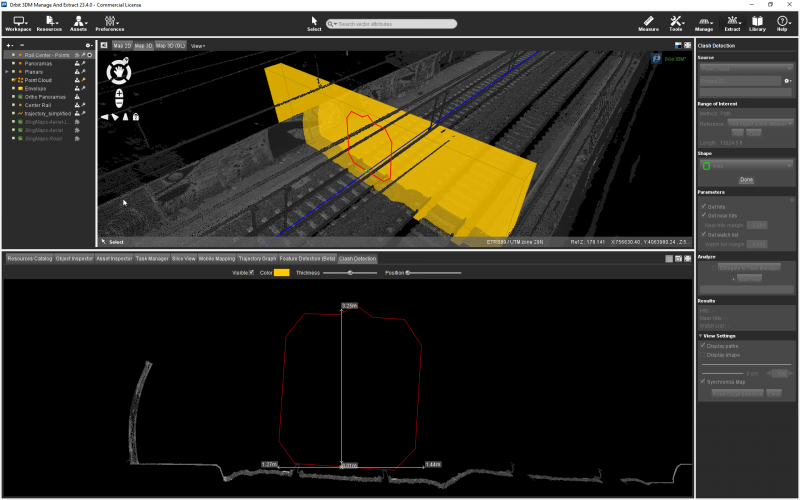For documentation on the current version, please check Knowledge Base.
Clash Detection
This page describes the Orbit desktop extension “Clash Detection”.
![]() Main Toolbar > Extract > Clash Detection
Main Toolbar > Extract > Clash Detection

Concepts
The Clash Detection extension detects clusters of points within a volume that is defined by moving a vertical shape along a 3D path.
Clusters detected within the shape are hits. There are two buffers around the shape: near hits and watch list clusters.
The vertical shape can be added to the Clash detection via the Shape creator extension.
The extension uses the concepts and generic workflow of Point Cloud Based Extensions.
Range of Interest
A Line or Point dataset can be used as Path.
Rail Track Roll
The rail track roll can be applied to position the Clash Detection Shape.
This requires the Range of Interest Path to be a sequence of points, having a roll value attribute.
Accepted Attribute Value Names:
FD_OrbitOrientationRoll(Created by Orbit when using the Dataset Preset Rail)OrbitOrientationRoll(Created by Orbit to import Mapping Resource Photo Positions)OrientationRollRoll
Shape
Drop-down menu of available shapes
Choose the 2D shape from the list of default and custom-made shapes. Use the Shape Creator to add new shapes.
Position Shape on Path
Opens the “Clash Detection” tab, and gives the possibility to adjust the position of the 2D Shape on the 3D Path. By default, the shape will be centered around the path, by drag & drop it can be re-positioned.
Parameters
Generic concepts, see Preferences for Detectors
Interpolate roll
Roll is applied to the shape when it is available as attribute of the reference path lines. A line should have 2 attributes, ROLL_1 and ROLL_2 that correspond to the roll at the start and end points of the line. If interpolate roll is not checked, the ROLL_1 is applied to the shape at the start of the line and the ROLL_2 is applied at the end. If interpolate roll is checked, intermediate roll values are calculated and applied at predefined steps of the line (Interpolate step).